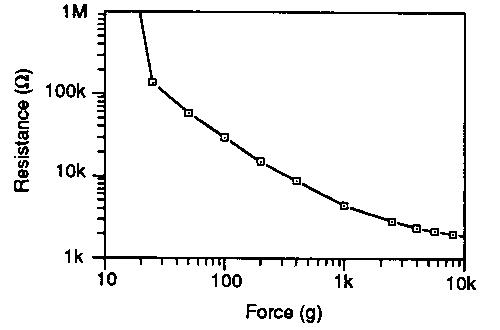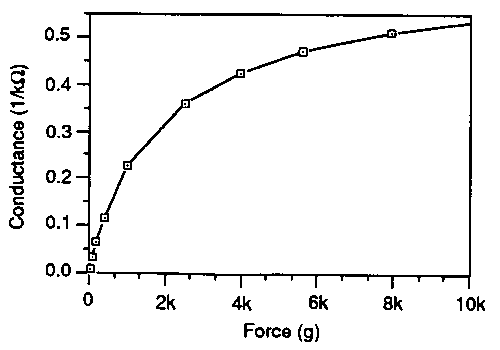What's An FSR?
The Force Sensing Resistor™ is a polymer thick film (PTF) device which exhibits a
decrease in resistance with any increase in force applied to the active surface. Its
force sensitivity is optimized for use in human touch control of electronic devices.
The FSR is not a load cell or strain gauge. Though it has similar properties,
it is not suited for precision equipment.
Force (grams) vs. Resistance

The FSR force vs. resistance characteristic shown in Figure 1 provides an overview of
the FSR's typical response behavior. For interpretational convenience, the force vs.
resistance data are plotted on a log/log format. These data are representative of
our typical devices, with this particular force vs. resistance characteristic being the
response of standard part #152 (1.27cm diameter circle) with a 0.6mm thick silicone rubber
(50 durometer) overlay and using a 0.56 cm diameter flat probe for actuation. In
general, the FSR's response approximately follows a power-law characteristic.
At the low force end of the force-resistance characteristic a switch-like response is
evident. This threshold, or "break force", that swings the resistance from
greater than 1M to about
50-100 k to about
50-100 k (the beginning of
the power-law) is controlled by the top substrate material and overlay thickness and
flexibility. At the high force end of the dynamic range, the response deviates from
the power-law behavior, and eventually saturates to a point where increases in force yield
little or no decrease in resistance. (the beginning of
the power-law) is controlled by the top substrate material and overlay thickness and
flexibility. At the high force end of the dynamic range, the response deviates from
the power-law behavior, and eventually saturates to a point where increases in force yield
little or no decrease in resistance.
Force (grams) vs. Conductance

In Figure 2, force vs. conductance (1/resistance) is shown. This format allows
simpler interpretation on a linear scale. Notice that the response is in the range
of 0-2kg, which is common to human interface applications, is very linear. A simple
circuit called a current-to-voltage converter (see TechNote; Suggested Interfaces 1-7)
takes advantage of this inverse proportionality and can be useful where response linearity
is desired.
|